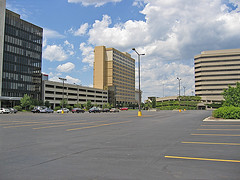Another model for retrofitting suburbia: the university campus

Posted March 31, 2009 at 1:35PM
In the early 1990s, Diane Dulken, who used to direct communications in NRDC's Washington office (and now has a consulting business in the Pacific Northwest), posed a fascinating idea for recycling dysfunctional suburbs: reshaping auto-dependent "office parks" into mixed-use communities modeled on the traditional university campus. While Diane's concept may have been before its time then, it could not be more timely now.
Much of commercial suburbia is falling on very hard times during the recession as companies and big-box stores are cutting back and closing locations.  Even before the recession, demographic and real estate guru Chris (Arthur C.) Nelson was reporting that fully 24 percent of our nonresidential development becomes obsolete each decade, with the typical lifespan of retail development less than 20 years. Nelson estimated in 2006 that 63 billion square feet of nonresidential building space would go out of service just between 2000 and 2025. Surely the recession has only raised those numbers.
Even before the recession, demographic and real estate guru Chris (Arthur C.) Nelson was reporting that fully 24 percent of our nonresidential development becomes obsolete each decade, with the typical lifespan of retail development less than 20 years. Nelson estimated in 2006 that 63 billion square feet of nonresidential building space would go out of service just between 2000 and 2025. Surely the recession has only raised those numbers.
To squeeze lemonade from lemons, this will present a multitude of sites with tremendous redevelopment opportunity when the economy recovers. And turning some of these concrete failures into campus-like communities might actually be one of the easier approaches. Here's what Diane wrote in Planning back in 1992:
"The campus is generally at the heart of a self-contained-neighborhood. It offers a vibrant mix of public and private spaces, linked by pedestrian routes. Housing, work, shopping and recreation are all quickly and easily accessible. Most important, the campus offers ample open spaces, making it particularly attractive to suburbanites.
"In fact, the university campus generally adheres to the basic principles of a neotraditional town. It puts a variety of functions within reach of pedestrians (while offering other transportation choices as well); it offers housing for people of different incomes and lifestyles, from single parent to classic family to elderly; and it restores public life by creating streets and plazas where people can gather comfortably.
"It's easy to imagine what a university-style district could be like. Instead of classrooms think of offices; instead of dormitories, apartments and townhouses.
Instead of a student union, a university-style district would support a community center and child care facilities. Other components of university life translate directly: films and plays, swimming pools, tennis courts, and gymnasiums; shopping districts on the campus edge; and a variety of housing, from multifamily to mansions, radiating from the campus . . .
"The first university-style district could well be a retrofit of an existing office park, perhaps one that has run into financial trouble during the early stages of development and whose developers might be receptive to a different strategy."
Likewise, I would think, for one that has run into financial trouble later in its existence. Some of the building stock would already be in place, and the vast parking lots that usually accompany the form could be used for lawns, pocket parks and additional buildings that increase the diversity, walkability and density of the current form. It's an intriguing concept, if also one that needs to be elaborated and thought through. Diane wants to revive the idea now that retrofitting suburbs is enjoying more attention from planners, and it will be interesting to see where she and others might go with it. Visit her website here.
This is his 300th post on Switchboard.